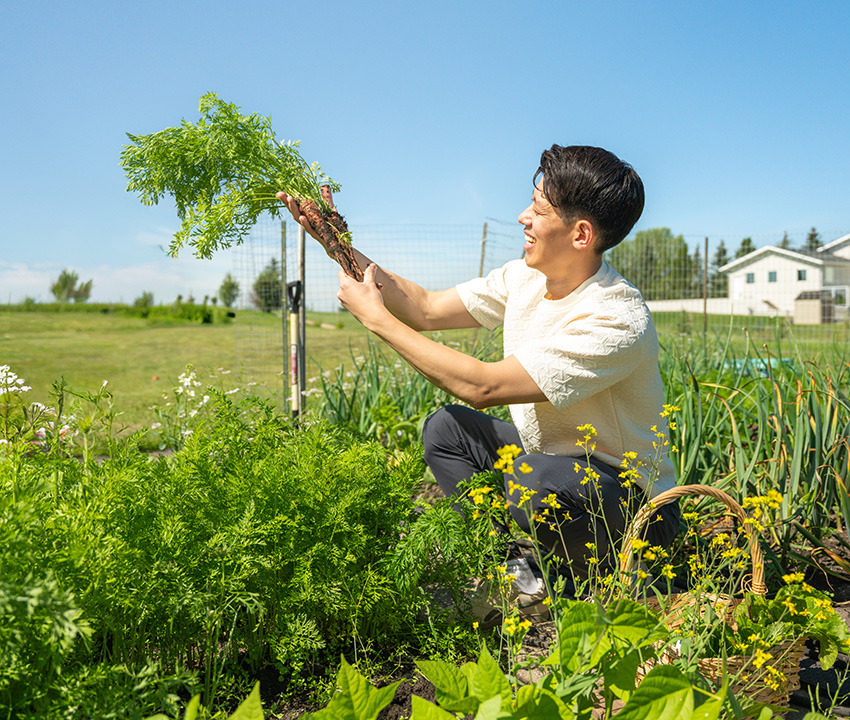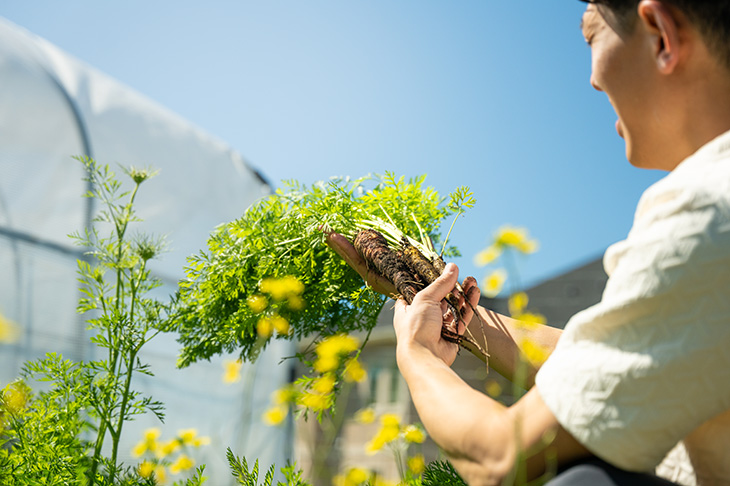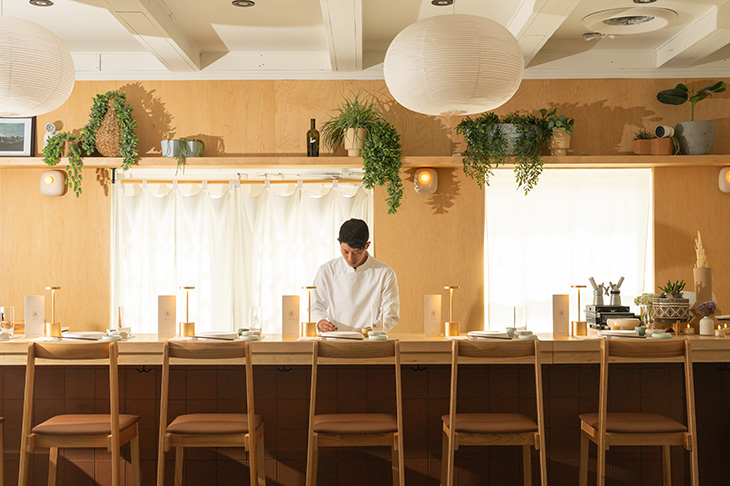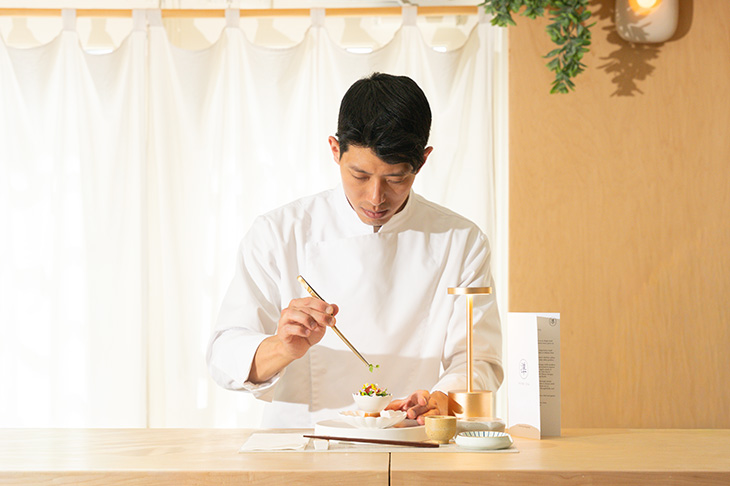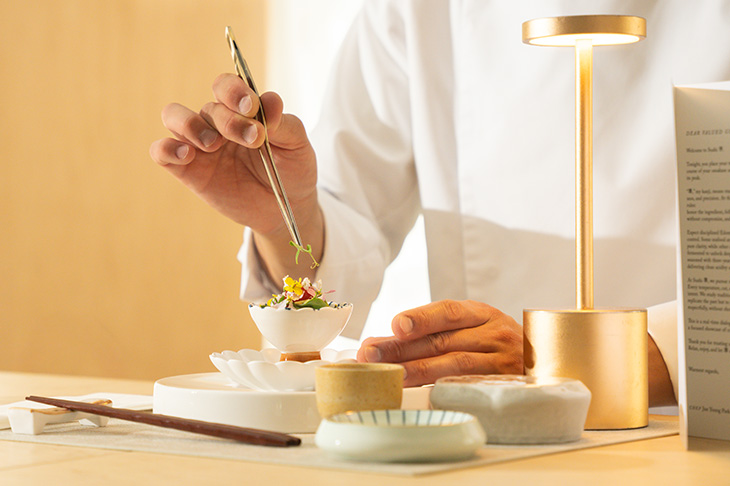Chef/owner and culinary art director Jun Young Park (PCK ‘18) has been preparing meals for people since he was a child living in Korea. Luckily for sushi and ramen lovers in Calgary, he’s brought his considerable experience and love for seasonal, home-grown ingredients to three locations of Ryuko, the much-lauded restaurant he opened in 2021. A few nights a week, he creates a special dinner, up to 21 courses, including fish from Japan and fresh produce from his garden.
LINK writer Jennifer Allford spoke to Chef Park about his love of cooking — and gardening.
What inspired you to become a chef?
My family was involved in the restaurant business and taught cooking. I grew up with that. When I was about five or six, I cooked Korean instant noodles. You just put them in water, then boil them. My mom was so happy having the instant noodles. I remember thinking, ‘Oh, I can make other people happy with my cooking!’ When I was 13 or so, I worked in the kitchen of my mom’s restaurant in Korea. I was young, but it was a family business, so I was expected to help. Even then, I believed I would be a chef one day.
I worked in many different types of restaurants in both Korea and Canada. I’ve done pizza, burgers, big chain restaurants, fine dining — and I’ve done my best to absorb all the skills and knowledge from different restaurants, different leaders and different chef/owners.
Where does good cooking start?
It all begins with quality ingredients, which is very important to me. The fish I use comes from all over the world, mainly from Japan and Korea. I also focus on seasonal foods found in the region as much as possible. In the summer, I take produce mostly from my garden and in the winter, I try my best to buy from local Alberta growers and farmers.
What do you think about when you’re planting your garden?
I think about my guests and what I can make for them. I want guests to experience the pure flavour of each dish. While planning and working in my kitchen, I try to minimize the cooking process so dinner guests can enjoy the natural taste of each ingredient.
As a chef, I believe that we need to learn how to grow our food. I see a lot of young or newer cooks who don't know what a Brussels sprout looks like in the ground. They’ve only experienced vegetables that have been washed, processed and packaged. If young cooks learn how to garden, then they will better understand the ingredients — how vegetables grow and how we can grow them better to enhance their flavours and nutritional value. Another benefit of this is sustainability and minimizing our carbon footprint.
Your Ryuko West location serves “omakase” a few nights a week. What is omakase?
In Japanese, omakase means ‘up to you.’ So basically, trust the chef. For example, I pulled a carrot from the ground this morning, and I started thinking, ‘How can I best prepare and deliver this fresh, sweet carrot flavour to my guests?’ I usually serve 18, 19, sometimes 21 courses per dinner. And I explain why I made each course and why I chose certain seasonal ingredients, which often offer the best flavour and nutrition. It’s a very personalized dining experience. Omakase is common in Asia, but only a couple of restaurants do it in Calgary.
What advice do you have for younger chefs?
I have a favourite quote, ‘The magic you are looking for is in the work you are avoiding.’ I really wish I knew this when I was younger.
A lot of young chefs I see get bored easily by having to do the same thing in the kitchen every day. But I strongly believe that to succeed, you have to try to make it better every day. It's consistent discipline.
Also, I think a lot of young people think if they just keep working in one place under the same chef, they will learn things and one day figure out their life. But that’s not true. Maybe they're working for someone else's future. They need to work hard but also spend time developing their skills and knowledge to make their own future better.

Like what you are reading?
Find more stories from past, present and upcoming issues of LINK magazine!
Oki, Âba wathtech, Danit'ada, Tawnshi, Hello.
SAIT is located on the traditional territories of the Niitsitapi (Blackfoot) and the people of Treaty 7 which includes the Siksika, the Piikani, the Kainai, the Tsuut’ina and the Îyârhe Nakoda of Bearspaw, Chiniki and Goodstoney.
We are situated in an area the Blackfoot tribes traditionally called Moh’kinsstis, where the Bow River meets the Elbow River. We now call it the city of Calgary, which is also home to the Métis Nation of Alberta.
